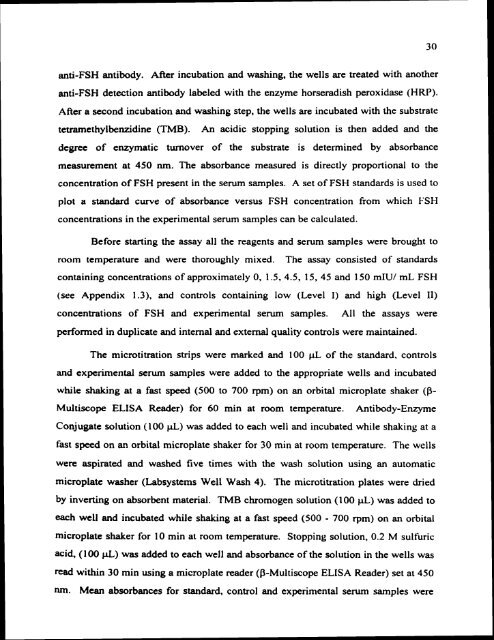ON TESTIS AND EPlDlDYMlS OF RATS - Pondicherry University ...
ON TESTIS AND EPlDlDYMlS OF RATS - Pondicherry University ...
ON TESTIS AND EPlDlDYMlS OF RATS - Pondicherry University ...
Create successful ePaper yourself
Turn your PDF publications into a flip-book with our unique Google optimized e-Paper software.
anti-FSH antibody. After incubation and washing, the wells are treated with another<br />
anti-FSH detection antibody labeled with the enzyme horseradish peroxidase (HRP).<br />
After a second incubation and washing step, the wells are incubated with the substrate<br />
tetramcthylbenzidine (TMB).<br />
An acidic stopping solution is then added and the<br />
degree of enzymatic turnover of the substrate is determined by absorbance<br />
measurement at 450 nm. The absorbance measured is directly proportional to the<br />
concentration of FSH present in the serum samples. A set of FSH standards is used to<br />
plot a standard curve of absorbance versus FSH concentration from which FSH<br />
concentrations in the experimental serum samples can be calculated.<br />
Before starting the assay all the reagents and serum samples were brought to<br />
room temperature and were thoroughly mixed.<br />
The assay consisted of standards<br />
containing concentrations of approximately 0, 1.5, 4.5, 15.45 and 150 mIU/ mL FSH<br />
(see Appendix 1.3), and controls containing low (Level 1) and high (Level 11)<br />
concentrations of FSH and experimental serum samples.<br />
All the assays were<br />
performed in duplicate and internal and external quality controls were maintained.<br />
The microtitration strips were marked and 100 pL of the standard. controls<br />
and experimental serum samples were added to the appropriate wells and incubated<br />
while shaking at a fast speed (500 to 700 rpm) on an orbital microplate shaker (P-<br />
Multi~ope ELISA Reader) for 60 min at room temperature.<br />
Antibody-Enzyme<br />
Conjugate solution (100 pL) was added to each well and incubated while shaking at a<br />
fast speed on an orbital microplate shaker for 30 min at room temperature. The wells<br />
were aspirated and washed five times with the wash solution using an automatic<br />
microplate washer (Labsystems Well Wash 4). The microtitration plates were dried<br />
by invening on absorbent material. TMB chromogen solution (100 pL) was added to<br />
each well and incubated while shaking at a fast speed (500 - 700 rpm) on an orbital<br />
microplate shaker for 10 min at room temperature. Stopping solution, 0.2 M sulfuric<br />
acid, (100 a) was added to each well and absorbance of the solution in the wells was<br />
read within 30 min using a microplate reader (P-Multiscope ELISA Reader) set at 450<br />
nm. Mean absorbances for standard, control and experimental serum samples were

















